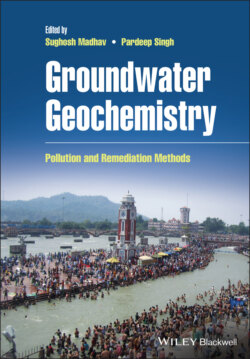Читать книгу Groundwater Geochemistry - Группа авторов - Страница 116
4.4 Effects on the Human Body
ОглавлениеThe various diseases like nausea, vomiting, diarrhoea, cyanosis, cardiac arrhythmia, confusion and hallucinations can arise in the human body owing to short‐ term consumption of arsenic. The long‐term consumption of arsenic through food, water, and other sources is associated with various types of health problems like skin disease (hyperpigmentation), skin cancer, tumours in lungs, bladder, kidneys, and liver, spontaneous abortion, depression, numbness, sleeping disorders, and headaches (Ali et al. 2012; Singh et al. 2015). Poisonous levels diverge between various compounds; for example, monomethyl arsenic acid and inorganic arsenide have higher levels of deadliness than arsenic choline. Acute toxicity is generally higher for inorganic arsenic compounds than for organic arsenic compounds (Hughes 2002). Arsenic can also cause low birth weight. Owing to the serious effect of arsenic on people's health, WHO recommended 10 μgL−1 As in drinking water in 2001 (WHO 2001). The US Environmental Protection Agency and European Commission have also revised the maximum contaminant level (MCL) for arsenic in drinking water to 50–10 μgL−1 (EPA 2002; European Commission Directive 1998).
As discussed in Section 4.3.3.2, Hg is found in three forms as metallic, inorganic, and organic Hg. The exposure of organic mercury is more lethal than inorganic mercury. The organic Hg is consumed through fish, water, and food in the body and it can cause different human health issues. The long‐term consumption of Hg causes various symptoms in the human body like damage to the nervous system and circulatory system, skin problems, and kidney disease. It also causes rheumatoid arthritis, which shows symptoms over a long period (Järup 2003, Azimi et al. 2017; Filter 2020). Owing to their poisonous nature, WHO and BIS reported the acceptable limit of mercury in water as summarized in Table 4.1.
The impact of Cd on human health is more dangerous. When Cd is exposed in very low quantities, it causes nausea with vomiting, headache, and cough. However, the intake of cadmium in high quantities affects kidney and liver. Cd can replace calcium from bones, which is the reason for different bone diseases like painful bone disorders, renal failure, and insinuation in human hypertension. The long period exposure of Cd can cause chronic anaemia (Järup 2003; Burke et al. 2016).
Intake of Pb over the acceptable limit is carcinogenic for humans. The short‐term as well as long‐term exposure to lead affects children more than adults. The intake of Pb through water, food and other resources causes various diseases like damage to the foetal brain, kidney disease, and circulatory and nervous system damage. Pregnant people exposed to lead through food and water can experience miscarriage, stillbirth, premature delivery, and low birth weight (Järup 2003).
Generally, the toxicity of Sb is similar to the toxicity of arsenic. The Sb(III) is more carcinogenic than Sb(V). The inhalation of antimony leads to carcinogenic disease and respiratory system problems. The intake of Sb in higher quantities leads to premature delivery, miscarriage, liver damage, etc. (WHO 2003; Sundar and Chakravarty 2010).
Zn is as an essential element to intake up to an acceptable limit; it helps in various metabolic processes, embryonic development, cellular differentiation, and cell proliferation. Moreover, it also delivers the substrates for the manifestation of genetic potential like optimum growth, health, reproduction, and development. However, the consumption of high doses of Zn is hazardous and leads to depression, lethargy, neurological signs, and thirst increment diseases (Plum et al. 2010).
Chromium (Cr) is also a more toxic element. Both forms, Cr(III) and Cr(VI), are carcinogenic for humans. But Cr(VI) is more lethal than Cr(III) because of its more powerful oxidizing agent, which has a tendency to be irritating and corrosive and it is easily inhaled by human cells, which have seen the carcino‐toxicity. The long‐term consumption of Cr affects the respiratory system, cardiovascular system, haptic system, gastrointestinal system, etc. It can also cause carcinogenic diseases (Zhitkovich 2011; Mcneill et al. 2012; Wilbur et al. 2012).
Overall, the consumption of heavy metal/metalloids over the permissible limit by humans through drinking water leads to skin problems, stomach problems, and carcinogenic problems. It produces different types of cancer like lung, kidney, skin, etc. The intake of heavy metals causes brain‐related diseases like Parkinson’s disease, disturbances in nerve cells, brain tumours, depression, and more (Momodu and Anyakora 2010; Mebrahtu and Zerabruk 2011; Mohod and Dhote 2013). Day by day, human health is deteriorated by consuming the contaminated water and toxic food. Keeping in mind their toxicity, several researchers are working to overcome this problem and demonstrate the methods to decontaminate the water bodies. The government has propounded some strategies to stop water pollution and water problems, which are discussed in Section 4.5.
